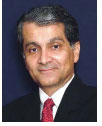While foreign capital rushes into the Indian real estate market, the long-term future of the industry lies in the hands of Indians themselves, according to Surendra Hiranandani, founder and managing director of the Hiranandani Group, the Mumbai-based real estate development firm.
A new, positive mindset about opportunities in India is taking shape among young people who are increasingly returning to India after studying abroad, said Hiranandani, who spoke with India Knowledge at Wharton following his appearance on a panel during the fall member’s meeting hosted by Wharton’s Samuel Zell and Robert Lurie Real Estate Center. The panel was titled, “Global Hot Spots — How to think about Hot Foreign Markets.”
“The real growth story is going to be from the people themselves,” said Hiranandani. “You can’t just put money into a place where people don’t want to work, where people don’t want to look at growth, or look at a better lifestyle.”
In the years following Indian independence, an anti-capitalist, socialist regulatory regime pervaded the country as a reaction to colonialism, Hiranandani said. After free-market reforms were introduced in the early 1990s, India is now experiencing a sustainable annual economic growth rate of 8%, creating new opportunities in real estate and other industries. “Capitalism was associated with colonialism and that hangover is now way past,” said Hiranandani. He noted a recent poll among corporate executives and management students in which Bill Gates replaced Mahatma Gandhi as the most revered person in India.
Hiranandani believes that India’s relatively young population — with an average age of 24 — will create continued demand for property. “There is a huge supply gap. It’s definitely an under-exploited market.”
Global Hot Spot
The Indian real estate market is now a hot spot for global investors after new laws were enacted last year allowing foreigners to own 100% of real estate assets. As a result, foreign real estate firms are rushing into the country searching for projects and local partners, such as the Hiranandani Group. Founded in 1980, the company has developed mixed-use communities at Powai and Thane and is the main developer of a 90-story residential building in Dubai with 57 swimming pools throughout the tower.
Following the panel discussion, Hiranandani gestured toward the American real estate investors attending the meeting and said, “Suddenly my competitors are all these guys. They’re now buying land from farmers. I should be doing this, not them.” He noted that many multinational real estate companies have had trouble coming into India because they are highly bureaucratic and are not interested in doing smaller transactions. “The bigger the company, the more time they take to make decisions. They’re so big they say, ‘We don’t have time for a $50 million deal.’ But you have to start somewhere. You might have to start with $5 million in India.”
He reassured nervous foreign investors that they should not fear being taken advantage of by Indian partners or the government. New capital coming into India is generating greater openness in business. “When capital is scarce, people find nefarious ways of raising it,” said Hiranandani. “The availability of capital automatically makes it more transparent.”
Hirananandi stressed India is attractive to U.S. and other Western investors because English is spoken in most regions as a first language and the culture is open to foreigners. “There’s no xenophobia in India against foreign capital,” he said. “There’s more of that in China and Japan. You can walk in as an American with blonde hair and walk into a slum in India and nobody is going to touch you. You are safe.”
Foreign investors may even have a leg up with the government over Indian companies these days, he told the panel. “You will probably have less problem with the government than I would as a local. The government is scared of institutions and will fool around more with private individuals.”
Comparisons Are Odious
While the panelists listed favorite new hot spots, including Germany, Japan and China, Hirandandani explained that the Indian economy only began to open up in 1991 and should not be compared to China, where free-market systems began to take hold in 1979. Only now, he said, are the effects of Indian reforms beginning to become evident.
Hiranandani added he is tiring of the constant comparisons between real estate investment opportunities in India and China. “I don’t think it’s necessary to compare the two because both countries are so large, each is going to have its own requirements and needs for housing,” he said. “Ultimately there has to be somebody wanting to occupy those houses and those offices. Both India and China are going to do that.”
He argued that the Indian and Chinese economies should no longer be typecast — India as a provider of services and China as a manufacturer. Both countries are now expanding in services as well as manufacturing. “These countries are large enough to have competency in all aspects,” he said. “They are large enough to have what it takes to lift many millions into the middle class.”
Hiranandani is most optimistic about the prospects for residential development as millions of Indians continue to migrate to the cities. While land prices may seem to be hitting unsustainable heights to people who already live in those cities, migrants are willing to pay a premium. “They want to be part of the action. They want to be part of the big story,” he said. “In the last three years, whatever I thought was expensive turned out to be cheap.”
However, he believes commercial development in India may be headed for some rough times because large Singapore builders came in and may have overbuilt. His firm is bullish on residential development, but he pointed out the sector is time consuming and difficult for foreigners to master.
Residential development is harder than commercial, he said. “You have to ask what kind of kitchen does the Indian housewife want? Or, what should be the size of the bedroom? For us, it’s a no-brainer; we do it all the time. We just listen to the sales counter.” Hiranandani said there is huge potential for developers in getting Indians to trade up in housing. “People have the money. They don’t know what it is to upgrade — you have to show it to them. You’re going to see a lot of activity in housing.”
Stuart Rothenberg, managing director at Goldman, Sachs & Co. and head of the Real Estate Principal Investment Area said real estate investors outside of India worry about going into the market. “There’s so much excitement about India, but people are worried about being a sucker — the foreigner who doesn’t know what they don’t know.”
To get around the problem, he said, Goldman Sachs tries to focus on assets in a portfolio of non-performing loans that may be strong properties with more effective management. The firm sticks to existing assets in a new market and will only consider new development once it has a good handle on the potential yield and has its own staff established in the country. Rothenberg said there are attractive deals in China, but they take a lot of time and energy to complete. He said his firm has only bought a few buildings in China’s major cities. “And that’s with a lot of trying over the last five years.”
Michael Pralle, president and chief executive officer of GE Real Estate with a $48 billion portfolio, said his firm’s top market pick these days is Japan, where the economy is recovering and prices remain near 25-year lows. He said GE did its first transaction in India only a year ago. “Other people were in India earlier,” said Pralle. “We are pretty cautious.”
Pralle said foreign real estate companies must be pragmatic about their investment timeframe in India and China. While the markets are growing fast and will be important in the long-term, they will yield relatively small returns over the next three to five years. “You work months and months to get these deals closed because they are more complicated. They are potentially more volatile, and the government can change on a dime.”
He said GE generally enters a new market with a local partner that has a specialty in the property type GE wants to acquire in each country. For example, it has a multifamily partner in France and has decided to focus on IT parks and residential projects in India. The firm’s parent company helps it forge relationships with desirable partners in emerging markets because GE is usually already doing business in the country and is well known. “We have a modest edge because of our parent company, which has big investments in India and China,” he said. “When we come in to do real estate, we have some confidence we will be treated relatively fairly.”
Investing in China
China is the top market for Keith Barket, senior managing director at Angelo, Gordon & Co., an alternative money management firm with $10 billion invested. Barket said his firm does not take on large portfolios, but makes single asset acquisitions in a targeted, “rifle-shot” approach. The firm began to look beyond U.S. holdings more than six years ago and was drawn to China by rapid economic growth projected to hit 9% for years to come.
Angelo Gordon uses a partnership model for its real estate investments, which works well in the United States, but has been harder to duplicate in China because there are fewer equity partners available. However, he said he can also run into big differences in managing local partnerships in the United States. For example, he noted there are major cultural variations between Angelo Gordon’s partners in New York and those in the Midwest.
Hiranandani said his main concern about India is that it is not developing fast enough. He pointed to delays in airport development as an example. “How fast can we get things going across the country?” he asked. “There is so much need, and that is why we need more capital coming in.” He is enormously optimistic about India’s potential. “The future is definitely bullish. We are seeing the market in its infancy. If you look at the stages of development, you will find India is where America was in the late 19th Century. There’s so much to do.”



